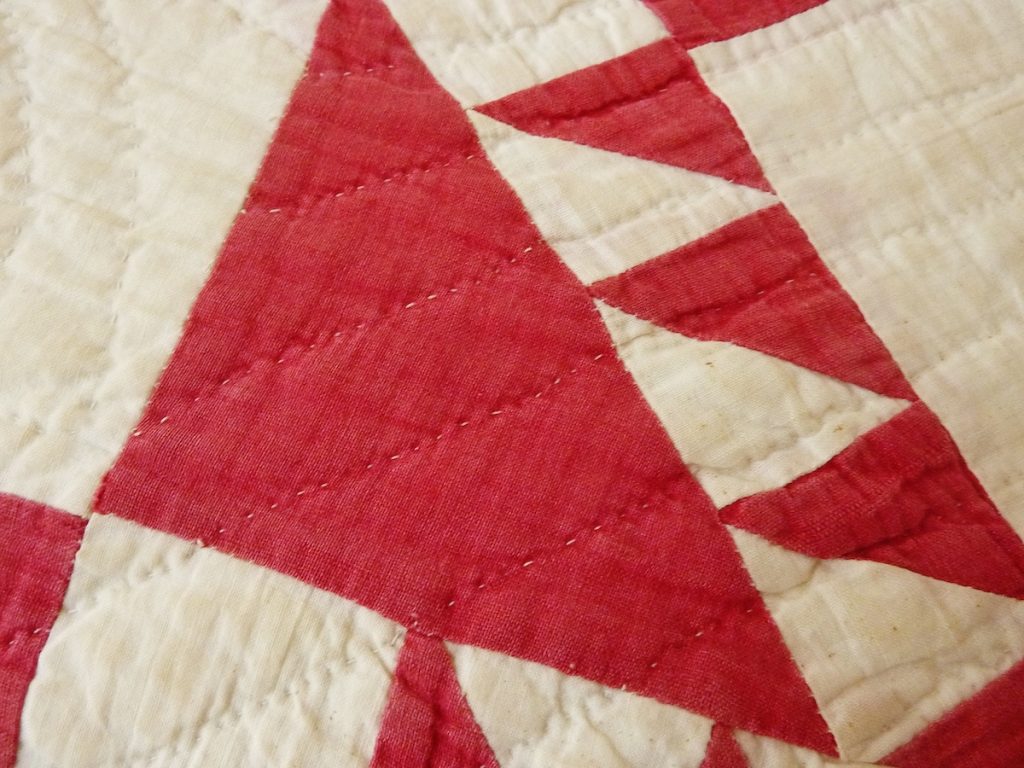Quilting in America

SB has a red and white American quilt, created in the late 19th century, which belonged to her great-grandmother. The motif features the star pattern known as the shooting star, the lucky star, or the falling stars. SB doesn’t say if her great-grandmother made the quilt, but having been born 150 years ago – in 1874 – we can reasonably suppose that, if she did, she would have sewn this quilt around 1890. This is a definite probability, because young girls in 19th century rural America as a tradition created a baker’s dozen quilt “tops” (just the decorative cover) in advance of a proposal of marriage. A young girl’s quilt top collection usually consisted of 12 utility “tops” and one masterpiece quilt for her bridal bed. The difference is that the everyday utility quilts were created from scraps of old fabric, usually from worn out clothing, and hand-pieced together. The masterpiece bridal bed quilt was an applique quilt, constructed by sewing a series of fabric shapes onto a fabric backing. Once she was engaged, she would finish the quilt ‘sandwich’ – a linen bottom or liner, a padded interior, and a decorative quilt cover, artfully stitched together.
Self-sufficient American females are central to the history of quilt making. Many cultures used padded fabrics for clothing, bedding, and armor, but for English and Dutch colonists in North America, quilting took on a distinctive role for the household sleeping quarters, and quilts were used for drafty windows and doorways as well. In the 17th century – the early years of American colonization – Colonial women spun wool and sewed clothing for the family, but blankets were a few weeks’ work on the household loom. Homes were cold and blankets were scarce, so early settlers saved scraps of fabric. When clothing wore out, the scraps became the decorative “piece work” quilt tops, which would be a patchwork fabric joined to the padding by intermittent bindings of yarn, or perhaps the decorative top was joined to the layers by needlework.

These early (pre-1800s) quilts were not “artistic,” they were functional. The simplest, most geometric designs of American quilts tend to be the earliest. The earliest homesteaders had no labor or materials to spare: the block-style (geometric) quilt was an example of this functional approach to design. Another quilting tradition comes from the Amish colonists in the 18th century in the American Midwest and Pennsylvania. The medallion quilt was born, a central motif surrounded by multiple borders.
The appliqué quilt, such as SB owns, is a much later form (1860-70s), and is called a “laid-on” quilt: a top made of white cloth with smaller pieces of contrasting fabrics cut into shapes or forms that are applied or stitched down. The high point of quilters working in this style was 1850, when affluent women had the leisure time to create beautiful, artistic designs, and quilting was a social event. The quilting bee allowed for the finishing of several quilts in a single day instead of weeks or months. In the mid-1800s the invention of the sewing machine changed those hand-sewn quilts. The invention of a separate quilting attachment for a sewing machine by Henry Davis changed quilting from handwork to sewing machine work. “Inspect your quilt,” as SB recommends. Her quilt is clearly hand-sewn, because she can see the irregular stitching.
Here are a few interesting Americana facts about quilts: the term quilt comes from the Latin culcita, meaning a stuffed sack; we have learned that a quilt is a cloth sandwich with a decorated top, a back, and a filler in the middle. The classification may be “patchwork” fabric, but there are many types. For example, I own a “summer” quilt, with no middle filling.
When the U.S. entered WWI in 1917, the government put out this advertisement: “Make Quilts – Save the Blankets for Our Boys Over There.” The government requisitioned all the wool produced for commercial use and redirected it to the war effort in 1918, instituting, as well, “heatless Mondays” to save fuel. So American women got busy quilting again. Likewise, during WWII, the Red Cross suggested that American women make community “signature quilts,” and sell them for the war effort, and I have seen many of these. Businesspeople, local philanthropists, and private folks would pay a quilter a small fee to have their names embroidered on quilt appliqués. The finished quilt was raffled off with proceeds going to the Red Cross.
SB’s quilt, circa 1870, is worth $500. But older American quilts can be worth much more in good condition. For direction on preserving a vintage quilt, I advise speaking to a fabric conservator (for example, email Winterthur Museum in Delaware) for treatment plans.







You must be logged in to post a comment.